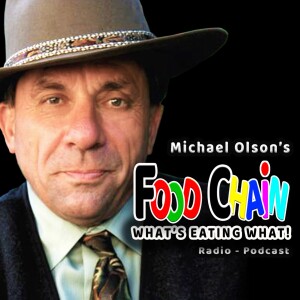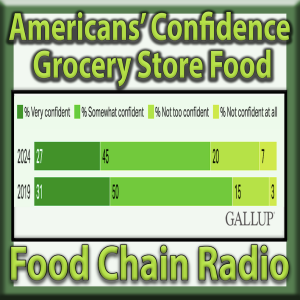
1.4K
Downloads
75
Episodes
It’s a fact! 100% of men, women and children eat food, and 97.5% of must buy their food from others who bring it from an average of 2,000 miles away. And so the hungry ask: ”What’s in this tomato? Who planted that broccoli? Is it safe to eat genetically engineered corn? Why are they irradiating meat? Are we running short of water? Why is China growing our apples? What will happen to us if we can no longer farm? How safe is our food chain?” The Food Chain is an audience-interactive syndicated newstalk radio program and podcast broadcasting weekly on radio stations and streaming on demand on the internet. The Food Chain, which has been named the Ag/News Show of the Year by California’s legislature, is hosted by Michael Olson, author of the Ben Franklin Book of the Year award-winning MetroFarm, a 576-page guide to metropolitan agriculture. The Food Chain is available live via GCN Starguide GE 8 and delayed via MP3/FTP. For clearance and/or technical information, please call Michael Olson at 831-566-4209 or email michaelo@metrofarm.com
Episodes

Tuesday Apr 01, 2025
Ep 1389 Call-of-the-Wild Meat
Tuesday Apr 01, 2025
Tuesday Apr 01, 2025
There is, one hopes, a little call-of-the-wild left in all of us – even those of us who live in a concrete box stacked 40 stories high in a city sky! That call leads us to ask:
Where can one get a good taste of wild meat?
The Food Chain Radio Show - Podcast with Michael Olson hosts Daniel Laggner, Owner & Butcher, Wild Stag Provisions, for a conversation about food that is as close to the wild as commercially possible.
Topics include why one would want to eat wild meat when domestic meat is so readily available; how the business of wild meat works; and the best way for one to get a good taste of call of the wild meat.

Thursday Mar 27, 2025
Ep. 1388 Food Chain Radio Podcast with Michael Olson
Thursday Mar 27, 2025
Thursday Mar 27, 2025
They live where we can’t see them for a very good reason! They come in the night – and during the day– to steal the precious fruits of our labor. Their unrelenting assault on our good nature leads us to ask:
How can we get that #%*%# gopher?
The Food Chain Radio Show - Podcast with Michael Olson hosts Thomas Wittman of Gophers Limited, for a conversation about controlling gophers in the farm and garden.
Topics include why gophers make farmers and gardeners so frustrated; the ways in which gophers are controlled on the farm and in the garden; and reasons why gophers should be managed without poisons.

Friday Mar 21, 2025
Food Inflation
Friday Mar 21, 2025
Friday Mar 21, 2025
Michael Olson hosts
Dr. Jacob Manlove, Assistant Professor of Ag Economics, Arkansas State University
MSN recently served up some news that caught my attention. The headline read, “Venezuela triples wages but still not enough to buy food.”
The writer went on to say that Venezuela’s new minimum wage of seven million bolivares per month is not enough buy two pounds of meat.
Shortly after reading this story I enjoyed a leisurely meal with my lady at a nearby sit-down restaurant.
The meal was very good, but nothing special, just a couple of burgers and beers. What did make the meal special was the check that, with tip, approached a hundred dollars!
Yes! Almost a hundred bucks for a couple of burgers and beers!
It is becoming increasingly evident that more money is buying less food. And that leads us to ask:
Can what happened to the price of food in Venezuela happen to the price of food in the US?

Wednesday Mar 12, 2025
Ep 1387 Feeding the Family
Wednesday Mar 12, 2025
Wednesday Mar 12, 2025
Michael Olson host Nutritionist / Author Jill Troderman
Some facts: One in five children are obese. Two in five adults are obese. The rate at which we are becoming obese has doubled since 1990. A question:
What should we feed the family?
The Food Chain Radio Show - Podcast with Michael Olson hosts Jill Troderman, award-winning nutritionist and author of The Food Tree, for a conversation about how best to feed one’s family.
Topics include why so many are so overweight; the health dangers of eating too much of the wrong foods; and how best to feed the family for a healthy future.

Friday Mar 07, 2025
French Chef – Taking the Heat!
Friday Mar 07, 2025
Friday Mar 07, 2025
Michael Olson with Executive Chef Avram Samuels, Director of Culinary and Food & Beverage Operations, Chaminade Resort and Spa, Santa Cruz, CA
In 1963, California native and World War II veteran Julia Child showed up on Boston’s PBS television to tout her book on French cuisine. It took her over a decade to get off that station! During that time, Child’s “The French Chef” changed America’s taste in food. And so we ask:
What makes French cuisine so French?
The Food Chain Radio Show - Podcast with Michael Olson hosts Executive Chef Avram Samuels for a conversation about being a classically-trained chef of French cuisine.
Topics include the essential difference between French and Italian cuisines; the difference between classical and modern French cuisine; and how a classically-trained French chef combines his artistry with the business of feeding Silicon Valley techies business banquets.

Tuesday Feb 18, 2025
Food Crash - A Farmer on Offense
Tuesday Feb 18, 2025
Tuesday Feb 18, 2025
A FOOD CHAIN RELEASE FROM MICHAEL OLSON
Yogi Berra once gave this piece of sage advise: “When you get to a fork in the road, take it!” And so we ask:
Which way should we grow our food: our way or nature’s way?
The Food Chain Radio Show - Podcast with Michael Olson hosts Dr. Felix Zu Lowenstein, farmer & author of Food Crash: Why Organic is the Only Way Forward, for a conversation about his insistence that growing food organically is the only way forward.
Topics include why human civilization is facing a major food crash in its immediate future; how this crash is consequent to the industrial technologies used to grow food; and why organic agriculture presents the only way to ensure a future of plentiful, healthy food.
Show Recording: “Food Crash: A Farmer on Offense” (#1384)
Radio: www.santacruzvoice.com
Host: www.metrofarm.com
Sponsor: TimeShare Media

Tuesday Feb 11, 2025
Ep 1383 About Food: A Farmer On Defense
Tuesday Feb 11, 2025
Tuesday Feb 11, 2025
According to a University of Minnesota survey, 75% of people trust farmers, but only 24% trust food. That leads us to ask:
Why do so many people trust farmers, but so few trust food?
The Food Chain Radio Show - Podcast with Michael Olson hosts Dennis Bulani, 4rth Generation Saskatchewan farmer, CEO of The Rack Petroleum & Author About Food: What a Farmer Wants you to Know, for a conversation about the efficacy and safety of industrial agriculture’s food.
Topics include: why so many people trust farmers, but so few trust food; what the farmer would like people to know about the efficacy and safety of his food; and whether people can be made to trust food that comes from so far away.

Tuesday Jan 28, 2025
Ep. 1382 Infertility on the Menu
Tuesday Jan 28, 2025
Tuesday Jan 28, 2025
Food Chain Radio Podcast with Michael Olson
Infertility on the Menu
They say men today have 60% less sperm than their grandfathers, and if the decline is not reversed, the sperm count in American males will drop to zero by 2045. That thought leads us to ask:
Can eating the wrong food cause our population to collapse?
The Food Chain Radio Show - Podcast with Michael Olson hosts Samantha LeJune, Researcher, Population Research Institute, for a conversation about the possibility that we are eating ourselves to infertility.
Topics include the real life consequences of Paul Erhlich’s 1968 book, The Population Bomb; why America’s young adults are have trouble conceiving and carrying to term their offspring; and which foods might be causing this deadly infertility.
Radio: www.santacruzvoice.com
Host: www.metrofarm.com
Sponsor: TimeShare Media
